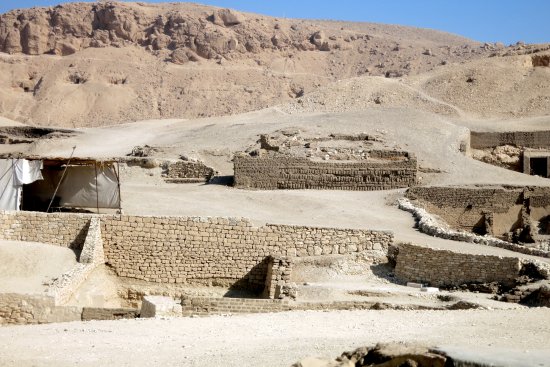before we know valley of the nobles , A tomb is a closed space designed to hold the dead along with their possessions. Ancient Egyptians made their tombs significant and architectural by painting colorful scenes on the walls and dividing them into chambers. The primary purpose of a tomb is to preserve the remains of the dead. Egyptians were particularly careful with their dead because they believed in the afterlife. Some of the most elaborate tombs in history were built by the ancient Egyptians, especially those for their kings.
The typical Egyptian tomb, known as a mastaba, had two main chambers: a ceremonial chamber and a burial chamber. The larger room was used for ceremonies honoring the dead, while the smaller room housed a statue of the deceased so their spirit could witness the rituals. The Valley of the Kings, Queens, and Nobles in Luxor showcases how Egyptians buried their royals and noblemen in a sophisticated and artistic way. These hidden underground tombs were carefully designed and painted with scenes of the afterlife and daily life practices.
The tombs of the nobles, in particular, reflect a shift in ancient Egyptian art toward the Amarna style during the New Kingdom. These tombs portray more daily life scenes of court men and common Egyptians. Since the Valley of the Nobles is one of Luxor’s key attractions, Travel to Egypt has included it in their Nile River cruise packages and Luxor day tours. The tombs are numerous and well-preserved, and we’ll provide some details about this breathtaking historical site if you’re planning to visit Egypt soon.

Valley of the nobles
The Valley of the Nobles contains tombs built for the elite of the Egyptian courts, including high priests and leaders from the Middle and New Kingdoms. These tombs feature a simple, consistent design. They are well-preserved, with most remaining intact.
The walls still display vibrant scenes showing workers in the fields, architects, craftsmen, musicians, and daily life in the Egyptian court. The Valley of the Nobles is located on the west bank of Luxor city. Each tomb is identified by a number. Among them, the tomb of Ramose, numbered 55, is the most famous. Additionally, other notable tombs in the Valley include those of Khaemhet and Neferhabef.
Tomb of Sennufru
Sennefer was Mayor of Thebes at the time of Amenhotep I. His tomb, TT 96, is eminent for its roof: skilled workers at the time misused the abnormality of its surface to embellish it with vines, thus its name. This tomb is additionally noted for the nature of its craft and for its fine condition of conservation. The present portrayal covers the funerary chamber (TT96B) yet in addition the surface sanctuary (TT96A), still in course of rebuilding..
Tomb of Rekhmire
Tomb 100 is another significant tomb in this burial ground. It had a place with Re-khme–e, who was vizier of Tuthmosis III and Amenhotep II.
This stone cut tomb has sections designed with many painted scenes of the different practices of life in Ancient Egypt. One of the most lovely scenes is the one that speaks to the minister of the court Re-khme-Re, conveying presents and tributes to the King of Egypt and his men. These presents and tributes included things, for example, utensils, horticultural items, and different creatures. One of the most significant content in this tomb is the one which makes reference to the obligations and duties accepted by the minister so as to give the equity a chance to win on Earth.
At the point when you visit the tombs, it is critical to recall the quantity of the tomb you need to visit. Along these lines you can visit precisely what you need to see; else, you will be lost.
Tomb of Nakht
The owner of this tomb was a respectable man who had the title of incredible recorder. He was likewise a cosmologist in the Temple of Amon during the reign of King Tuthmosis IV. His wife was additionally engaged with the exercises carried on in the Temple, as she filled in as a chanter. The tomb is genuinely little yet has the absolute most splendid beautiful scenes. These scenes are very much well preserved.
Tom of Ramose
The best tomb in the Valley of the Nobles is undoubtedly the tomb of Ramose. This impressive tomb belongs to Ramose, an instructor from Thebes who lived during the reigns of King Amenhotep III and Akhenaton (Amenhotep IV) in the eighteenth Dynasty.
Ramose lived until the fifth year of King Akhenaton’s reign. Evidence shows that other noblemen later used and altered this tomb, likely removing references to Akhenaton. The sacred priest Ramose of Amon Ra held significant power. The tomb’s decoration reflects his high status.
The most intriguing feature of the tomb is its depiction of the sun disk, the god Aton, highlighting the names and figures of Akhenaton’s wives and children. Additionally, the scene includes other high priests with long mantles and clean-shaven heads.
Inside, the southern section displays a vivid scene of a funeral ceremony with female mourners. Here, servants carry offerings to the deceased. The eastern wall features relief sculptures created by the best artisans of the eighteenth Dynasty.
Another large scene shows Ramose sitting with his wife and their pet goose. On the southern wall, a fresco depicts Ramose’s funeral, his possessions, and the offerings made for him. Another scene shows mourners weeping and a priest standing at the tomb’s entrance.
Tomb of Menna
This is one of the most famous and delightful tombs in the Valley of the Nobles. It features numerous prominent scenes and remains in excellent condition. The tomb belongs to the respected Menna, who held the title of land surveyor during King Tuthmosis IV’s reign. His role was crucial, as he was responsible for assessing the taxes to collect from farmers.
Inside, the tomb is filled with scenes depicting daily life. You can see images of construction, harvesting, farming, plowing fields, and winnowing.









